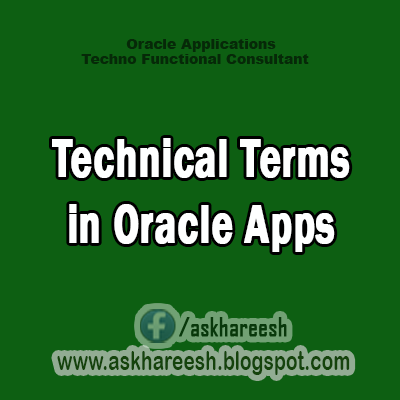The below example explains the important terms and concepts used in the Oracle E-Business Suite.
Say Hareesh is the owner of a wholesale laptop shop. He buys various laptops like Apple, Dell, Lenovo and HP etc from manufacturers directly and sells them to retail shop owners and also to the direct customers.
These manufacturers are referred to as VENDORS/SUPPLIERS in Oracle Applications. Hareesh
keeps track of all his vendors’ information like addresses, bank account and the amount he owes to them for the laptops that he bought etc, in a book named PAYABLES.
Hareesh gets an order from a retail shop owner of Lap Mart, for a shipment of 11 of Apple, 25 of Dell and 32 of Lenovo. In Oracle Apps, size is referred to as UOM (unit of measure), Lap Mart is called CUSTOMER and the order is referred to as SALES ORDER. Hareesh maintains a book called
ORDER MANAGEMENT where he writes down all the details of the SALES ORDERS that he gets from his customers.
Say the laptops have been shipped to the customer Lap Mart. Hareesh now sends him the details like cost of each Laptop, the total amount that the customer has to pay etc on a piece of paper which is called INVOICE / TRANSACTION. Once the INVOICE has been sent over, the customer then validates this against the actual quantity of laptops that he received and will process the payments accordingly. The invoice amount could be paid as a single amount or could be paid in installments. Hareesh’s customer, Lap Mart pays him in installments (partial payments). So Hareesh has to make a note of the details like date received, amount received, amount remaining, amount received for what goods/shipments/invoice etc, when Hareesh receives the payments. This detail is called RECEIPT, which will be compared to the invoice by Hareesh to find how much Lap Mart has paid to him and how much has to be paid yet. This information is maintained in a book named RECEIVABLES to keep track of all the customers, their addresses (to ship the items), what and how much he has shipped to his customers and the amount his customers owe him etc.
Hareesh’s laptop business has begun to improve and has attracted more and more customers. As a result, Hareesh decided to buy a building to stock more laptops. In Apps, this building is known as WAREHOUSE and all the laptops are referred to as INVENTORY. Due to increase in customers, Hareesh needs to hire more people to help him out in his business without any hiccups. These workers are called EMPLOYEES. At the end of every month, Hareesh pays the salary for all his employees through Checks. These checks are nothing but PAYROLL in Apps.
At the end of every month, Hareesh prepares a balance sheet in a book called GENERAL LEDGER to determine how much profit/loss he got and keeps track of the money going out and going in.
As the business grows, it becomes impossible to record everything on a paper. To make everybody’s life easier, we have very good tools in the market, which help the business men to keep track of everything. One such tool is Oracle E-Business Suite.
Oracle Applications is not a single application, but is a collection of integrated applications. Each application is referred to as a module and has it own functionality trying to serve a business purpose.
Few of the modules are Purchasing, Accounts Payables, Accounts Receivables, Inventory, Order Management, Human Resources, General Ledger, Fixed Assets etc.
Here is a high level business use of various modules:
Oracle Purchasing handles all the requisitions and purchase orders to the vendors.
Oracle Accounts Payables handles all the payments to the vendors.
Oracle Inventory deals with the items you maintain in stock, warehouse etc.
Order Management helps you collect all the information that your customers order.
Oracle Receivables help you collect the money for the orders that are delivered to the customers.
Oracle Human Resources helps maintain the Employee information, helps run paychecks etc.
Oracle General Ledger receives information from all the different transaction modules or sub ledgers and summarizes them in order to help you create profit and loss statements, reports for paying Taxes etc. For Example: when you pay your employees that payment is reported back to General Ledgers as cost i.e money going out, when you purchase inventory items and the information is transferred to GL as money going out, and so is the case when you pay your vendors. Similarly when you receive items into your inventory, it is transferred to GL as money coming in, when your customer sends payment, it is transferred to GL as money coming in. So all the different transaction modules report to GL (General Ledger) as either “money going in” or “money going out”, the net result will tell you if you are making a profit or loss.
All the equipment, shops, warehouses, computers can be termed as ASSETS and they are managed by Oracle Fixed Assets.

